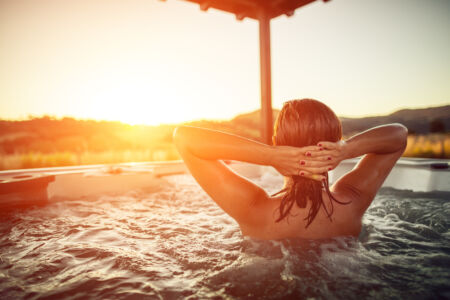
Dipping into a hot tub won’t cause varicose veins, but it could make your symptoms worse if you already have them.
With temperatures dropping and leaves changing, you may find yourself tempted to take a cozy dip into a hot tub. Unfortunately, while a toasty hot tub might provide relief from the cold, it may end up doing more harm than good for patients with varicose veins.
That’s because excessive heat exacerbates the uncomfortable symptoms of varicose veins, which is why you likely also experience more swelling, pain, and cramping in the summer months, when temperatures rise. Taking care of your veins is a year-round effort, which means avoiding hot tubs in the fall and winter months if you have varicose veins.
Heat alone does not cause varicose veins. However, if you already have varicose veins, sitting in a hot tub for a prolonged period of time forces the damaged veins to work even harder, increasing your discomfort.
When our bodies overheat, whether from the sun or hot water, blood rushes to the skin’s surface by way of the veins. In response, your skin turns a reddish color and you sweat to cool your body down. For healthy veins, this isn’t a problem. But when your veins are stretched thin, blood pools in the vein, pushing enlarged, twisted lines out from under the surface of the skin in the visible manifestation of varicose veins.
This excess blood overwhelms already weakened varicose veins. As veins work harder to pump blood back to the heart, your legs ache from the extra effort. What’s more, heat contributes to poor circulation in the legs caused by sluggish blood flow, which eventually leads to swollen feet and ankles. If you’ve ever noticed your feet and ankles swelling in the summer months, it’s likely due to the heat.
Leg cramping is further worsened by hot temperatures. As deoxygenated blood collects in the vein and toxins from that blood seep into the surrounding tissue, your legs tighten up. Cramping may also be heightened due to dehydration that depletes salt in the body. When that happens, you’ll experience “heat cramps,” which are more common in the summer months but can also occur if you lounge in a hot tub for too long.
For those reasons, avoiding hot tubs can reduce the painful side effects of varicose veins. Of course, you’ll want to stay warm in the fall and winter months. You can do that while also protecting your veins. Here’s how:
Avoid the Heat. When you take a shower or bath, make sure the water is warm, not hot. And don’t linger longer than you must; a quick shower or bath is best. Don’t crank up the heat in your home either. Keep the temperature at a comfortable level, but not excessively hot.
Hydrate. Whether in cold or hot weather, it’s important to drink plenty of water. Proper hydration prevents cramping and promotes smooth circulation in the veins.
Exercise. Instead of relaxing in a hot tub, do your veins a favor by exercising. Walking, biking, and swimming engage the calf muscles. And when you strengthen those muscles, they’re better able to support the veins in pumping blood back to the heart.
Get Treatment. You don’t have to live with the discomfort of varicose veins. Today’s surgical techniques are quick, nearly painless, and require very little down time. Once your varicose veins disappear, you can enjoy a day at a spa in a relaxing hot tub.
Healthy veins are vital to your overall well-being. The physicians at Center for Vein Restoration are specially trained in vascular disorders such as varicose veins. Come visit us today to discuss ways to maintain your vein health with surgical and non-surgical methods. We’re open for appointments.